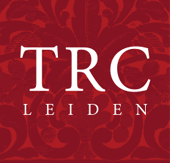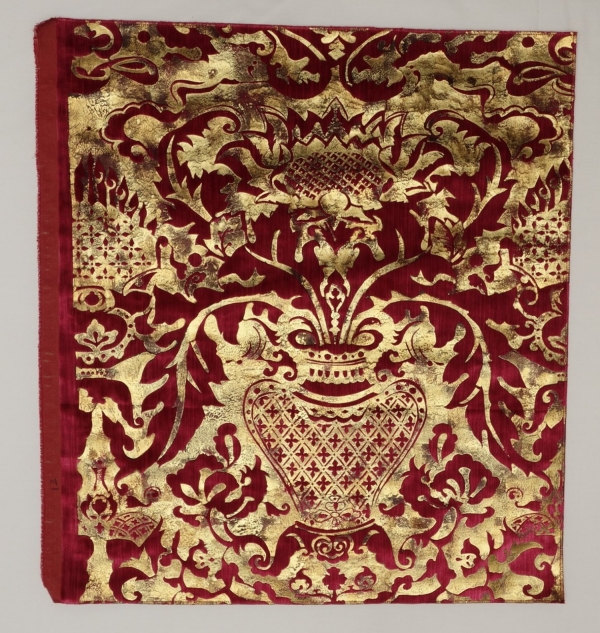These are various ways in which velvet can produce different effects, such as changing the type of fibre or thread used, varying the colour of the pile, using cut and uncut pile, changing the height of the pile and by including a range of different background weaves (plain, satin), as well as using pile as part of another type of cloth.
Block printed velvet
A form of velvet with a solid pile ground and a block printed design. In very expensive forms, gold paint is applied to wooden or metal blocks and the design is printed on the velvet by hand.
Brocaded velvet
A form of velvet with metal thread as part of the background. Compare TRC 2011.0363, TRC 2011.0370, TRC 2011.0371, TRC 2011.0372, TRC 2011.0373, and TRC 2016.2128.
Chiffon (or transparent) velvet
A very lightweight velvet on a sheer silk or rayon chiffon base.

A form of velvet where the pile uses cut and uncut loops to create a pattern. Compare TRC 2011.0368 and TRC 2011.0389.
Crushed velvet
A lustrous velvet with a patterned appearance that is produced by either pressing the fabric down in different directions, or sometimes by mechanically twisting the fabric while it is wet.
Cut velvet
A type of velvet in which the loops formed by the pile warp are all cut.
Devoré or burnout
A velvet treated with a caustic solution to dissolve areas of the pile, creating a velvet pattern upon a sheer or lightweight base fabric. Compare TRC 2017.0551 and TRC 2018.0894.
Double faced velvet
A form of velvet with a pile on both sides of the cloth.

A type of velvet that is extremely lustrous, appears dappled, and somewhat crushed.
Lyon velvet
A densely woven, stiff, heavy-weight pile velvet used for hats, coat collars and garments.
Mirror velvet
A type of exceptionally soft and lightly crushed velvet.
Nacré velvet
Velvet with an appearance similar to shot silk, whereby the pile is woven in one or more colours and the base fabric in another, creating a changeable, iridescent effect.
Panne velvet
A type of crushed velvet produced by forcing the pile in a single direction by applying heavy pressure. Sometimes, less frequently, called paon velvet. Since the 1970’s, the term ‘panne velvet’ has also been used for a pile knit velvet (sometimes called a velour), with a short pile that falls in many directions.
Pile-on-pile velvet
A particularly luxurious type of velvet woven with piles (cut or uncut) of differing heights to create a pattern.
 Advertisement in The Tatler, 1929, for printed velvet and dyed squirrel (TRC 2018.2546).Printed velvets
Advertisement in The Tatler, 1929, for printed velvet and dyed squirrel (TRC 2018.2546).Printed velvets
This is a form of velvet with a hand or machine printed design. Compare TRC 2007.0792; TRC 2018.1803; TRC 2018.2399; TRC 2018.2546; TRC 2018.2637, and TRC 2018.3399.
Solid (plain) velvet
A term used to indicate that the pile covers the entire ground and that there is no woven decoration. Compare TRC 1998.0368 and TRC 2001.0031.
Stamped (embossed)
A metal plate or roller is used to heat-stamp the fabric, producing a pattern. Compare TRC 1999.0255, TRC 2011.0367, and TRC 2018.2514.
Tie-and dye velvet
A plain or crushed velvet that has been hand coloured using a tie-and-dye technique.
Uncut velvet
Velvet in which the loops formed by the pile warp are left uncut. Compare TRC 2018.2513.
Utrecht velvet
Velvet made with a mohair pile and a linen ground. Compare TRC 2018.2502; TRC 2018.2503, and TRC 2018.2514.
Velour(s) (modern)
A form of velvet which has a knitted ground.
 Advertisement dating to 1885 showing a group of ladies, all wearing velveteen garments (UK, TRC 2018.2543).Velveteen (weft-pile weave)
Advertisement dating to 1885 showing a group of ladies, all wearing velveteen garments (UK, TRC 2018.2543).Velveteen (weft-pile weave)
Technically speaking, velveteen is a form of cloth in which the pile is created using supplementary weft threads, which are sometimes woven in the form of loops or as floating threads. The loops and floats are cut after weaving in order to create the pile. Sometimes, velveteen is described as an imitation velvet. Compare TRC 2018.2401 and TRC 2018.2543.
Voided velvet
A form of velvet that is deliberately woven with areas of ground that have no pile. Instead these areas are often produced with a tabby weave or satin weave in order to contrast with the piled areas. For voided velvet with a plain ground, compare TRC 2011.0374, TRC 2011.0375, and TRC 2019.0004. Fir void velvets on a satin ground, compare TRC 2011.0369.
Wedding ring or ring velvet
Another term for devoré and/or chiffon velvets, which are allegedly fine enough to be drawn through a ring.

